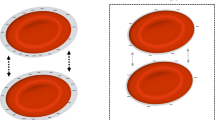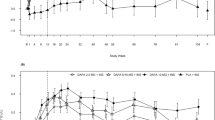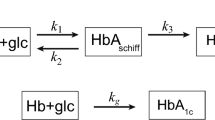Abstract
Increased red blood cell sodium-lithium countertransport (SLC) activity and elevated intracellular calcium have been observed in hypertensive patients. The association of these ion transport abnormalities with each other and with another phenotype, insulin resistance, has been suggested. We investigated whether elevated SLC activity and increased lymphocyte cytosolic calcium (Cacyt) occur in the same individuals and whether either is associated with hyperinsulinaemia. We measured SLC activity, lymphocyte Cacytand fasting insulin levels in hypertensive patients and normal subjects. Consistent with prior studies, SLC activity was significantly and positively correlated with fasting insulin levels (r = 0.45, P < 0.01). However, SLC activity and lymphocyte Cacyt were significantly but inversely correlated (r = −0.42, P < 0.01) and lymphocyte Cacyt was also inversely correlated with fasting insulin (r = −0.55, P < 0.001). When the study participants were instead separated into two groups based on fasting insulin levels, those above the median (15 μU/ml) had significantly higher SLC activity and significantly lower Cacyt. When separated by lymphocyte Cacyt levels (above or below 120 nM) those patients with low lymphocyte Cacyt had significantly higher SLC activity and significantly higher insulin levels. Multiple linear regression showed that fasting insulin was significantly predictive of SLC activity (P = 0.05) and Cacyt (P < 0.01). Thus, elevated SLC activity and increased lymphocyte Cacyt are separate and distinct ion transport phenotypes in hypertensive patients, linked through a relationship to hyperinsulinaemia that is direct with SLC activity and inverse with lymphocyte Cacyt.
This is a preview of subscription content, access via your institution
Access options
Subscribe to this journal
Receive 12 digital issues and online access to articles
$119.00 per year
only $9.92 per issue
Buy this article
- Purchase on Springer Link
- Instant access to full article PDF
Prices may be subject to local taxes which are calculated during checkout




Similar content being viewed by others
References
Canessa M et al. Increased sodium-lithium countertransport in red cells ofpatients with essential hypertension N Engl J Med 1980; 302: 772–776
Strazzullo P et al. Red blood cell sodium-lithium countertransport and risk of future hypertension: the Olivetti Prospective Heart Study Hypertension 1998; 31: 1284–1289
Laurenzi M et al. Baseline sodium-lithium countertransport and 6-year incidence of hypertension. The Gubbio Population Study Circulation 1997; 95: 581–587
Doria A et al. Insulin resistance is associated with high sodium-lithium countertransport in essential hypertension Am J Physiol 1991; 26: E684–E691
Zerbini G et al. Sodium-lithium countertransport has low affinity in hyperinsulinemic hypertensive subjects Hypertension 1995; 25: 986–993
Pontremoli R, Zerbini G, Rivera A, Canessa M . Insulin activation of red blood cell Na+/H+ exchange decreases the affinity of sodium sites Kidney Int 1994; 46: 365–375
Ceolotto G et al. Protein kinase C and insulin regulation of red blood cell Na+/H+ exchange Am J Physiol 1997; 272: C818–C826
Agam G et al. Elevated intracellular Ca2+ affects LiiNao countertransport in human red blood cells Biochim Biophys Acta 1987; 904: 207–215
Resnick LM et al. Intracellular ionic consequences of dietary salt loading in essential hypertension. Relation to blood pressure and effects of calcium channel blockade J Clin Invest 1994; 94: 1269–1276
Erne P, Bolli P, Burgisser E, Buhler F . Correlation of platelet Ca2+ with blood pressure. Effect of antihypertensive therapy N Engl J Med 1984; 310: 1084–1088
Alexiewicz JM et al. Effect of dietary sodium intake on intracellular calcium in lymphocytes of salt-sensitive hypertensivepatients Am J Hypertens 1992; 5: 536–541
Rivera A, Conlin PR, Williams GH, Canessa ML . Elevated lymphocyte cytosolic calcium in a subgroup of essential hypertension Hypertension 1996; 28: 213–218
McDonald JM, Pershadsingh HA, Colca J . The role of calcium and calmodulin in insulin receptor function in the adipocyte Ann NY Acad Sci 1986; 488: 406–417
Draznin B et al. Possible role of cytosolic free calcium concentrations in mediating insulin resistance of obesity and hyperinsulinemia J Clin Invest 1988; 82: 1848–1852
Tsien RY, Pozzan T, Rink TJ . Ca2+ homeostasis in intact lymphocytes: cytoplasmic free Ca2+ monitored with a new intracellularly trapped fluorescent indicator J Cell Biol 1986; 94: 325–334
Barbagallo M, Gupta RK, Laragh JH, Resnick LM . Ionic effects of insulin in normal and hypertensive erythrocytes: toward an ionic definition of insulin resistance J Hypertens 1993; 11: 399S–405S
Barbagallo M, Gupta RK, Resnick LM . Cellular ionic effects of insulin in normal human erythrocytes: a nuclear magnetic resonance study Diabetologia 1993; 36: 146–149
Baldi S et al. In vivo effect of insulin on intracellular calcium concentrations: relation to insulin resistance Metabolism 1996; 45: 1402–1407
Mattiasson I, Berntorp K, Lindgarde F . Sodium-lithium countertransport and platelet cytosolic free calcium concentration in relation to peripheral insulin sensitivity in postmenopausal women Clin Sci 1992; 83: 319–324
Delva P et al. Intralymphocyte free magnesium and calcium and insulin tolerance test in a group of essential hypertensivepatients Life Sci 1998; 63: 1405–1415
Levy J, Gavin JR, Hammerman MR, Avioli LV . Ca2+-Mg2+-ATPase activity in kidney basolateral membrane in non-insulin-dependent diabetic rats. Effect of insulin Diabetes 1986; 35: 899–905
Algenstaedt P, Antonetti DA, Yaffe MB, Kahn CR . Insulin receptor substrate proteins create a link between the tyrosine phosphorylation cascade and the Ca2+-ATPases in muscle and heart J Biol Chem 1997; 272: 23696–23702
Kim YC, Zemel MB . Insulin stimulation of intracellular free Ca2+ recovery and Ca(2+)-ATPase gene expression in cultured vascular smooth-muscle cells: role of glucose 6-phosphate Biochem J 1995; 311: 555–559
Natali A et al. Insulin sensitivity, vascular reactivity, and clamp-induced vasodilatation in essential hypertension Circulation 1997; 96: 725–726
Lew VL et al. The distribution of intracellular calcium chelator (fura-2) in a population of intact human red cells Biochim Biophys Acta 1993; 1148: 152–156
Zemel MB, Kraniak J, Standley PR, Sowers JR . Erythrocyte cation metabolism in salt-sensitive hypertensive Blacks as affected by dietary sodium Am J Hypertens 1988; 1: 386–392
Foyle WJ, Carstensen E, Fernandez MC, Yudkin JS . Longitudinal study of associations of microalbuminuria with the insulin resistance syndrome and sodium-lithium countertransport in nondiabetic subjects Arterioscler Thromb Vasc Biol 1995; 15: 1330–1337
Monciotti CG et al. Elevated sodium-lithium countertransport activity in erythrocytes is predictive of the development of microalbuminuria in IDDM Diabetologia 1997; 40: 654–661
Andronico G et al. Insulin, sodium-lithium countertransport, and microalbuminuria in hypertensivepatients Hypertension 1998; 31: 110–113
Acknowledgements
This work was supported by grants from VA Medical Research Service, National Institutes of Health (HL57173, HL04069, DK53538, DK02817, RR02635), and by Regione Veneto grant 782/01/97.
Author information
Authors and Affiliations
Corresponding author
Rights and permissions
About this article
Cite this article
Romero, J., Rivera, A., Monari, A. et al. Increased red cell sodium-lithium countertransport and lymphocyte cytosolic calcium are separate phenotypes in patients with essential hypertension. J Hum Hypertens 16, 353–358 (2002). https://doi.org/10.1038/sj.jhh.1001387
Received:
Revised:
Accepted:
Published:
Issue Date:
DOI: https://doi.org/10.1038/sj.jhh.1001387



